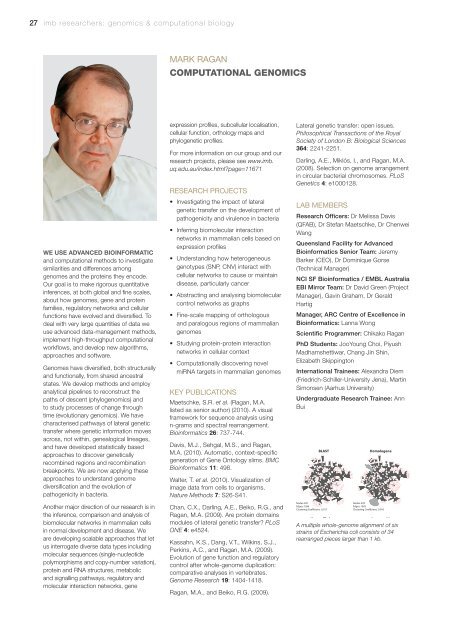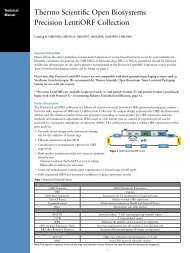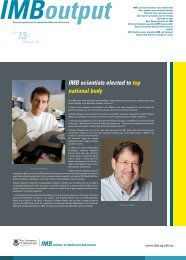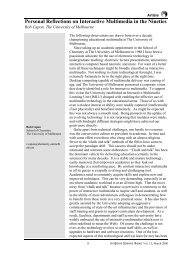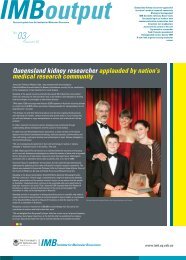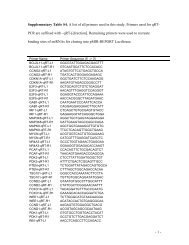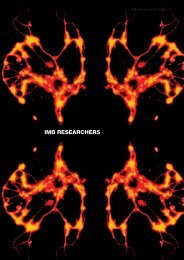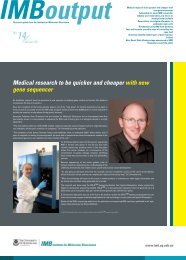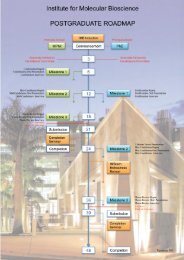2010 Annual Report - Institute for Molecular Bioscience - University ...
2010 Annual Report - Institute for Molecular Bioscience - University ...
2010 Annual Report - Institute for Molecular Bioscience - University ...
You also want an ePaper? Increase the reach of your titles
YUMPU automatically turns print PDFs into web optimized ePapers that Google loves.
27 imb researchers: genomics & computational biology<br />
MARK RAGAN<br />
COMPUTATIONAL GENOMICS<br />
WE USE ADVANCED BIOINFORMATIC<br />
and computational methods to investigate<br />
similarities and differences among<br />
genomes and the proteins they encode.<br />
Our goal is to make rigorous quantitative<br />
inferences, at both global and fine scales,<br />
about how genomes, gene and protein<br />
families, regulatory networks and cellular<br />
functions have evolved and diversified. To<br />
deal with very large quantities of data we<br />
use advanced data-management methods,<br />
implement high-throughput computational<br />
workflows, and develop new algorithms,<br />
approaches and software.<br />
Genomes have diversified, both structurally<br />
and functionally, from shared ancestral<br />
states. We develop methods and employ<br />
analytical pipelines to reconstruct the<br />
paths of descent (phylogenomics) and<br />
to study processes of change through<br />
time (evolutionary genomics). We have<br />
characterised pathways of lateral genetic<br />
transfer where genetic in<strong>for</strong>mation moves<br />
across, not within, genealogical lineages,<br />
and have developed statistically based<br />
approaches to discover genetically<br />
recombined regions and recombination<br />
breakpoints. We are now applying these<br />
approaches to understand genome<br />
diversification and the evolution of<br />
pathogenicity in bacteria.<br />
Another major direction of our research is in<br />
the inference, comparison and analysis of<br />
biomolecular networks in mammalian cells<br />
in normal development and disease. We<br />
are developing scalable approaches that let<br />
us interrogate diverse data types including<br />
molecular sequences (single-nucleotide<br />
polymorphisms and copy-number variation),<br />
protein and RNA structures, metabolic<br />
and signalling pathways, regulatory and<br />
molecular interaction networks, gene<br />
expression profiles, subcellular localisation,<br />
cellular function, orthology maps and<br />
phylogenetic profiles.<br />
For more in<strong>for</strong>mation on our group and our<br />
research projects, please see www.imb.<br />
uq.edu.au/index.htmlpage=11671<br />
RESEARCH PROJECTS<br />
• Investigating the impact of lateral<br />
genetic transfer on the development of<br />
pathogenicity and virulence in bacteria<br />
• Inferring biomolecular interaction<br />
networks in mammalian cells based on<br />
expression profiles<br />
• Understanding how heterogeneous<br />
genotypes (SNP, CNV) interact with<br />
cellular networks to cause or maintain<br />
disease, particularly cancer<br />
• Abstracting and analysing biomolecular<br />
control networks as graphs<br />
• Fine-scale mapping of orthologous<br />
and paralogous regions of mammalian<br />
genomes<br />
• Studying protein-protein interaction<br />
networks in cellular context<br />
• Computationally discovering novel<br />
miRNA targets in mammalian genomes<br />
KEY PUBLICATIONS<br />
Maetschke, S.R. et al. (Ragan, M.A.<br />
listed as senior author) (<strong>2010</strong>). A visual<br />
framework <strong>for</strong> sequence analysis using<br />
n-grams and spectral rearrangement.<br />
Bioin<strong>for</strong>matics 26: 737-744.<br />
Davis, M.J., Sehgal, M.S., and Ragan,<br />
M.A. (<strong>2010</strong>). Automatic, context-specific<br />
generation of Gene Ontology slims. BMC<br />
Bioin<strong>for</strong>matics 11: 498.<br />
Walter, T. et al. (<strong>2010</strong>). Visualization of<br />
image data from cells to organisms.<br />
Nature Methods 7: S26-S41.<br />
Chan, C.X., Darling, A.E., Beiko, R.G., and<br />
Ragan, M.A. (2009). Are protein domains<br />
modules of lateral genetic transfer PLoS<br />
ONE 4: e4524.<br />
Kassahn, K.S., Dang, V.T., Wilkins, S.J.,<br />
Perkins, A.C., and Ragan, M.A. (2009).<br />
Evolution of gene function and regulatory<br />
control after whole-genome duplication:<br />
comparative analyses in vertebrates.<br />
Genome Research 19: 1404-1418.<br />
Ragan, M.A., and Beiko, R.G. (2009).<br />
Lateral genetic transfer: open issues.<br />
Philosophical Transactions of the Royal<br />
Society of London B: Biological Sciences<br />
364: 2241-2251.<br />
Darling, A.E., Miklós, I., and Ragan, M.A.<br />
(2008). Selection on genome arrangement<br />
in circular bacterial chromosomes. PLoS<br />
Genetics 4: e1000128.<br />
LAB MEMBERS<br />
Research Officers: Dr Melissa Davis<br />
(QFAB), Dr Stefan Maetschke, Dr Chenwei<br />
Wang<br />
Queensland Facility <strong>for</strong> Advanced<br />
Bioin<strong>for</strong>matics Senior Team: Jeremy<br />
Barker (CEO), Dr Dominique Gorse<br />
(Technical Manager)<br />
NCI SF Bioin<strong>for</strong>matics / EMBL Australia<br />
EBI Mirror Team: Dr David Green (Project<br />
Manager), Gavin Graham, Dr Gerald<br />
Hartig<br />
Manager, ARC Centre of Excellence in<br />
Bioin<strong>for</strong>matics: Lanna Wong<br />
Scientific Programmer: Chikako Ragan<br />
PhD Students: JooYoung Choi, Piyush<br />
Madhamshettiwar, Chang Jin Shin,<br />
Elizabeth Skippington<br />
International Trainees: Alexandra Diem<br />
(Friedrich-Schiller-<strong>University</strong> Jena), Martin<br />
Simonsen (Aarhus <strong>University</strong>)<br />
Undergraduate Research Trainee: Ann<br />
Bui<br />
BLAST<br />
Nodes: 831<br />
Edges: 1266<br />
Clustering Coefficient: 0.017<br />
Human Phylome<br />
Nodes: 367<br />
Edges: 493<br />
Clustering Coefficient: 0.013<br />
MACHOS<br />
Homologene<br />
Nodes: 670<br />
Edges: 1005<br />
Clustering Coefficient: 0.010<br />
Inparanoid<br />
A multiple whole-genome alignment of six<br />
strains of Escherichia coli consists of 34<br />
rearranged pieces larger than 1 kb.<br />
Nodes: 503<br />
Edges: 705<br />
Clustering Coefficient: 0.015<br />
CORE


